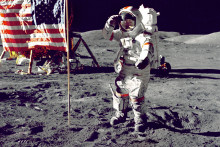Before Oscar Kamps began his current PhD research at the UT’s ITC faculty, he did an internship at the Lunar and Planetary Institute in Houston. It was during this internship two years ago that he worked on a study which investigated landing sites on the Moon. The study titled ‘Traverses for the ISECG-GER design reference mission for humans on the lunar surface’ was recently published at ScienceDirect.
‘The idea was to analyze a conceptual mission to the lunar surface,’ explains Kamps. ‘Our task was to assess possible landing sites, to see what could be done at each location in terms of research and then propose a specific plan for exploration – using human missions and rovers.’
‘The dark’ side
The study focused on the lunar south pole located on the far side of the Moon. ‘This region has never been reached by humans or robots,’ clarifies the UT scientist. ‘All the previous missions landed on the near side, but the south pole is of particular interest because it could help us understand the most about the Moon and its geological data.’ Among other things, there is a reason to believe that water could be found in the craters on the Moon’s south pole.
‘The Moon is really interesting for us because it preserves many of the geological processes that occurred early in our Solar System, during the time when life was formed. All the old rocks from the early planetary formation on Earth have been destroyed, but on the Moon they are still there. We could learn about the bombardment history and the lunar interior, for example,’ continues Kamps. ‘There are also craters on the lunar surface that are permanently without any sunlight and could contain water deposits. Hydrogen has been measured in those areas. The only way to know, however, is to go there.’

One human mission every year
According to the study, the way ‘to go there’ would include human crews visiting five landing sites, one each year, starting in 2028. The researchers further propose to use two rovers that would be tele-robotically operated between the sites and would meet with the crew at the time of the next landing. ‘We specifically checked whether the rovers could travel between the sites and they can, which means they could continue the proposed mission.’
The team of researchers, including Oscar Kamps, has presented the results of their work to engineers from NASA and at a planetary science conference. As Kamps says, the findings could be applied by anyone planning a human mission to the Moon. They could even become part of the future editions of the Global Exploration Roadmap which outlines the future of space exploration. ‘The paper isn’t only a scientific exercise, it’s also a message for the engineers,’ says the PhD candidate. ‘This way they can adapt the rovers, for example, and make them ready for such a mission.’
‘The next group of astronauts should be scientists’
As a planetary scientist, would Kamps be interested in going on such a mission himself? ‘In my research I focus on geology of Mars and perhaps one day we could use my work to prepare similar exploration plans for Mars. To be honest, planetary studies weren’t originally my goal, but now I would like to continue working in the field of space exploration and if an opportunity comes along to do such a mission I will take it. I believe the next group of astronauts going to the Moon or Mars should be scientists.’
The study referred to in this article: Allender, E.J., et al. Traverses for the ISECG-GER design reference mission for humans on the lunar surface. Adv. Space Res. (2018), https://doi.org/10.1016/j.asr.2018.08.032







